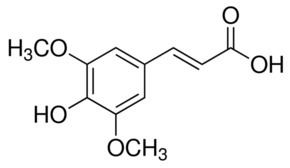Formula C11H12O5 Boiling point 249.2 °C | Molar mass 224.21 g/mol | |
 | ||
Sinapinic acid, or sinapic acid (Sinapine - Origin: L. Sinapi, sinapis, mustard, Gr., cf. F. Sinapine.), is a small naturally occurring hydroxycinnamic acid. It is a member of the phenylpropanoid family. It is a commonly used matrix in MALDI mass spectrometry. It is a useful matrix for a wide variety of peptides and proteins. It serves well as a matrix for MALDI due to its ability to absorb laser radiation and to also donate protons (H+) to the analyte of interest.
Contents
Sinapic acid can form dimers with itself (one structure) and ferulic acid (three different structures) in cereal cell walls and therefore may have a similar influence on cell-wall structure to that of the diferulic acids.
Sinapine is an alkaloidal amine found in black mustard seeds. It is considered a choline ester of sinapic acid.
Natural occurrences
Sinapinic acid can be found in wine and vinegar.
Metabolism
sinapate 1-glucosyltransferase is an enzyme that uses UDP-glucose and sinapate to produce UDP and 1-sinapoyl-D-glucose.
Sinapoylglucose—malate O-sinapoyltransferase is an enzyme that uses 1-O-sinapoyl-beta-D-glucose and (S)-malate to produce D-glucose and sinapoyl-(S)-malate.
Related compounds
Canolol is a phenolic compound found in crude canola oil. It is produced by decarboxylation of sinapic acid during canola seed roasting.
